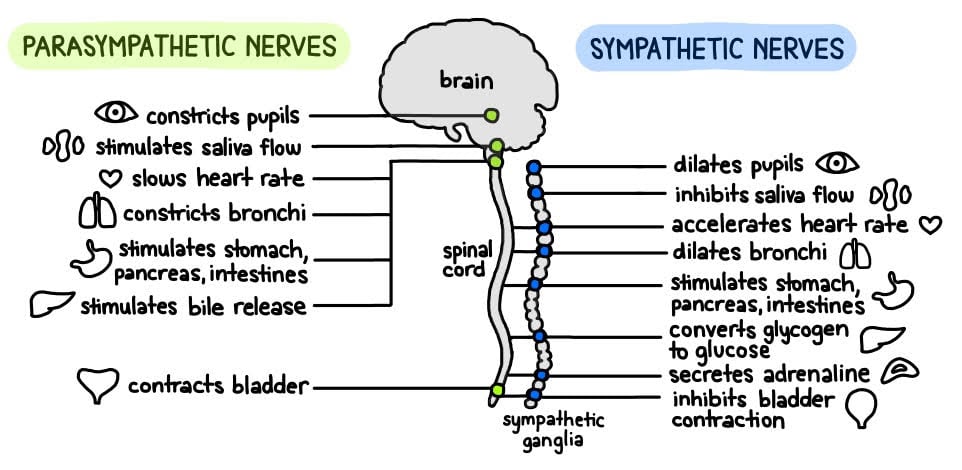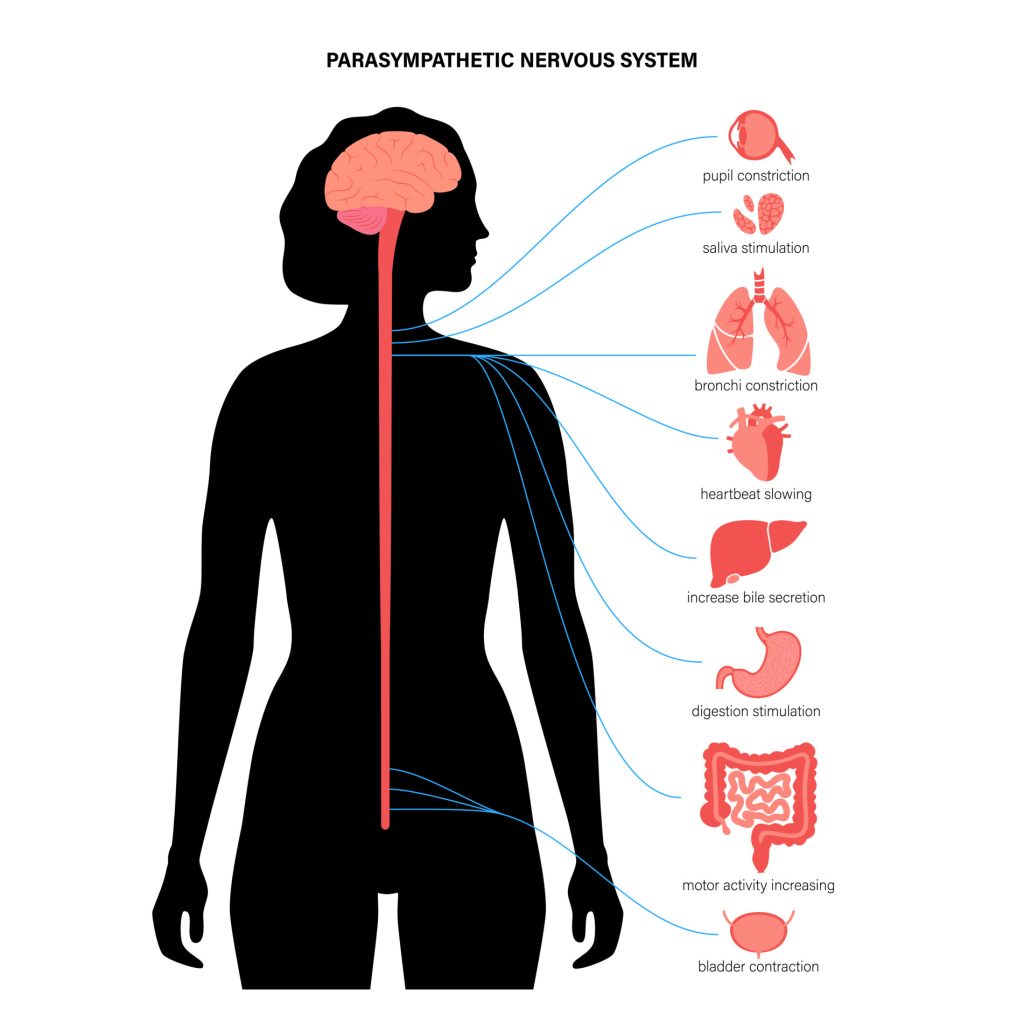On This Page:
The parasympathetic nervous system is a subdivision of the autonomic nervous system (ANS), which regulates bodily functions outside of voluntary control, therefore being automatic.
The PSNS begins in the brain and branches out via long fibers, leading to connecting neurons near the organs they intend to act upon, enabling quick responses.
It is also called the ‘rest and digest’ system as it conserves the body’s natural activity and relaxes the individual once an emergency has passed.
It promotes relaxation, energy conservation, and recovery by slowing the heart rate, stimulating digestion, and facilitating other processes when the body is resting. It counterbalances the sympathetic nervous system, which governs “fight or flight” responses.

The parasympathetic nervous system (PSNS) leads to decreased arousal in areas such as the eyes, glands that produce saliva, nerves in the stomach, blood vessels, and nerves that go to the bladder.
Functions
What does the parasympathetic nervous system do?
There are many responses associated with the parasympathetic nervous system (PSNS) and the organs of the body it affects.
The PSNS can decrease heart rate, especially when at rest after completing physical exercise or after stressful situations, where the heart would have been increased.

The response also constricts bronchi so that breathing is slowed to a resting pace. Within the eyes, the PSNS causes the pupils to constrict. Whilst the pupils would dilate in stressful times to allow more light to enter, this response is not required in relaxed situations.
The PSNS also causes the eyes to experience lacrimation, producing tears. This is to provide lubrication to the eyes to preserve their delicate tissue.
The PSNS also stimulates salivation of the mouth to enable the easier digestion of food through the enzymes within saliva. Digestion is also promoted within the stomach, causing it and the intestines to move about, as well as releasing bile for the body to digest fats.
The PSNS also contracts the bladder so that urination can occur, in addition to being able to move food within the intestines down the digestive tract to enable bowel movements.
Fight or Flight Response
Sympathetic activation prepares us for fight or flight, while parasympathetic activation is associated with normal functioning under relaxed conditions.
When the stressor subsides the parasympathetic branch of the nervous system is activated and the heart and breathing rate decrease, the digestion restarts and all other functions go back to their normal level.
The PSNS can also come into action after a stressful situation has concluded, essentially undoing all the work that the SNS has done to stimulate the body.
When stressed, the PSNS triggers the necessary responses to return to homeostasis (the maintaining of balancing internal physiology).
Without the PSNS, we may either constantly be in a state of elevated stress responses, or the regulation of our everyday bodily processes would be dysfunctional, such as being unable to digest food or control our bladder.
The PSNS, therefore, plays a vital role in physical and mental health by helping the body calm down from stress reactions that can cause adverse effects such as elevated blood pressure.
Nerves of the PSNS
Nerve fibres of the PSNS arise within the central nervous system. The primary nerves involved are cranial nerves . Below are some of the main cranial nerves in the PSNS:
- Vagus nerve – approximately 75% of all the parasympathetic nerves are vagus nerves. These nerves have branches in many key organs such as the stomach, kidneys, bladder, and reproductive organs.
- Oculomotor nerve – these nerves are able to help constrict the pupils.
- Glossopharyngeal nerve – these nerves project to the salivary glands to provide extra salivation to the tongue.
The PNS is made up of spinal nerves types which project from the sacral region of the spinal cord (known as S2, S3, and S4).
The sacrum nerves send signals to regions of the bladder, reproductive organs, and the colon. The axons of these nerves are typically quite long in length and extend into ganglia (a group of neuron cell bodies) in the rest of the body.
The ganglia are usually located close to the target organs, allowing the PSNS to send and receive signals throughout the body quickly.
Alike to the sympathetic branch, the PSNS consists of preganglionic and postganglionic neurons. The preganglionic nerves are located in the brain stem or sacral levels of the spinal cord and then project out to parasympathetic ganglia usually located near to the organs.
The postganglionic neurons will then complete the journey to the organs and activate the specific organs.
Acetylcholine Neurotransmitter
Neurotransmitters are the chemical messengers which are transmitted through neurons. The preganglionic neuron’s primary neurotransmitter is acetylcholine.
Acetylcholine is a neurotransmitter found in both the central nervous system and the peripheral nervous system and plays a role in brain and muscle function.
The preganglionic neurons within the thoracic and lumbar regions in the spinal cord carry acetylcholine and release it at synapses within the ganglia.
Acetylcholine is then taken up by the receptors on the postganglionic neurons outside of the spinal cord. Activation of this process results in signals being extended to target areas of the sympathetic nervous system and the release of another neurotransmitter called norepinephrine.
Acetylcholine is a neurotransmitter (chemical messenger) found in both the central and peripheral nervous systems. The main function of this type is focused on muscle movements, memory, and learning, associated with motor neurons.
Within the PSNS, acetylcholine is the chief neurotransmitter. Acetylcholine is stored within the vesicles of neurons and is released by postganglionic neurons when nerve impulses running down the neuron activate this response.
The acetylcholine then reaches the receptors of the postsynaptic membrane of a muscle fiber near the target organs. This will then change the absorbency of the postsynaptic membrane, causing channels to open that permit positively charged sodium ions to pass through into the cells of the muscle.
If nerve impulses build up to a significantly high frequency, this will cause the sodium channels along the membrane to become fully activated, resulting in muscle cell contraction.
The acetylcholine will then either stimulate or block a response, therefore having excitatory and inhibitory effects.
When the PSNS causes acetylcholine to reach muscle fibers, this can result in affecting bodily responses.
Within the cardiovascular system, the PSNS caused the acetylcholine to help in decreasing heart rate as well as decreasing heart muscle contraction. In the gastrointestinal system, the acetylcholine increased the movement of the stomach and causes digestive contractions, so food is able to be digested.
Within the urinary tract, the acetylcholine’s activity causes a decrease in the volume of the bladder and increased voluntary voiding pressure.
It also has effects on respiration, helping in slowing down breathing, and stimulates gland secretion by those who receive parasympathetic nerve impulses.
Dysfunction
Dysfunctions within the PSNS can be varied and may only affect one or more organs.
If the nerves in the system are damaged, this can interfere with messages sent between the brain and organs such as the heart, blood vessels, and sweat glands.
If there is a surplus of the neurotransmitter acetylcholine, this can result in some side effects. As this neurotransmitter sends signals to organs of the body involved in the PSNS, too much of this can result in cramps, muscular weakness, paralysis, diarrhea, blurry vision, and the overproduction of tears.
If the PSNS is underactive due to nerve damage, this could result in symptoms such as constantly high blood pressure and heart rate. This is because the parasympathetic is unable to function properly to calm down the body after times of stress, so you may find someone being in a constant state of stress when there is no visible trigger to this.
Autonomic dysfunction is a condition whereby the autonomic nervous system and its divisions do not work properly. This dysfunction can develop when nerves of the autonomic nervous system are damaged and can range from mild to life-threatening.
The most common cause of autonomic dysfunction is diabetes, but there could be hereditary reasons, as well as aging, Parkinson’s disease, or chronic fatigue syndrome being possible causes.
Below are some other symptoms of damage or dysfunction within the PSNS:
- Issues with digesting food – not being able to digest properly or at a slower pace than normal.
- Bladder dysfunction – this could result in incontinence or urine.
- Abnormal sweating – the sweat glands may be producing too much or too little sweat.
- Lack of pupillary response – the pupils may be unable to constrict after a stressful situation, so may always be appearing larger than normal.
- Lack of salivation – this can result in food not being digested properly.
- Bowel issues – this could be either constipation or too many bowel movements.
- Being unable to control internal body temperature .
- Visual problems, e.g. blurriness.
Autonomic dysfunction can be treated depending on the symptoms being experienced. For instance, if the cause of dysfunction is due to diabetes, controlling blood sugar will be the primary treatment.
In many cases, treatment of the underlying disease (if applicable) can allow damaged nerves within the ANS to repair and regenerate. Autonomic dysfunction can be diagnosed through a doctor taking their time in order to understand what exactly the issue is.
For example, using blood pressure monitors to test or high or low blood pressure, or using an electrocardiogram to measure heart rate.
Although medical conditions cannot always be treated, there are some quick solutions that may be useful in order to activate the PSNS if taking a while to recover from a stressful situation.
For instance, taking deep abdominal breaths can help in resetting the PSNS and bring heart rate down. Similarly, activities such as mindfulness, meditation and yoga have all been shown to help in relaxing and could even help bring the body return to homeostasis.
For more serious parasympathetic dysfunction, seeking a doctor’s advice is always recommended.
Sources
Britannica, T. Editors of Encyclopaedia (2019, September 6). Parasympathetic nervous system. Encyclopedia Britannica. https://www.britannica.com/science/parasympathetic-nervous-system
Lumen. (n.d.). Functions of the Autonomic Nervous System. Retrieved May 5, 2021 from https://courses.lumenlearning.com/boundless-ap/chapter/functions-of-the-autonomic-nervous-system/
Nall, R. (2020, April 23). Your Parasympathetic Nervous System Explained. Healthline. https://www.healthline.com/health/parasympathetic-nervous-system
Tindle, J., & Tadi, P. (2020). Neuroanatomy, Parasympathetic Nervous System. StatPearls [Internet].

